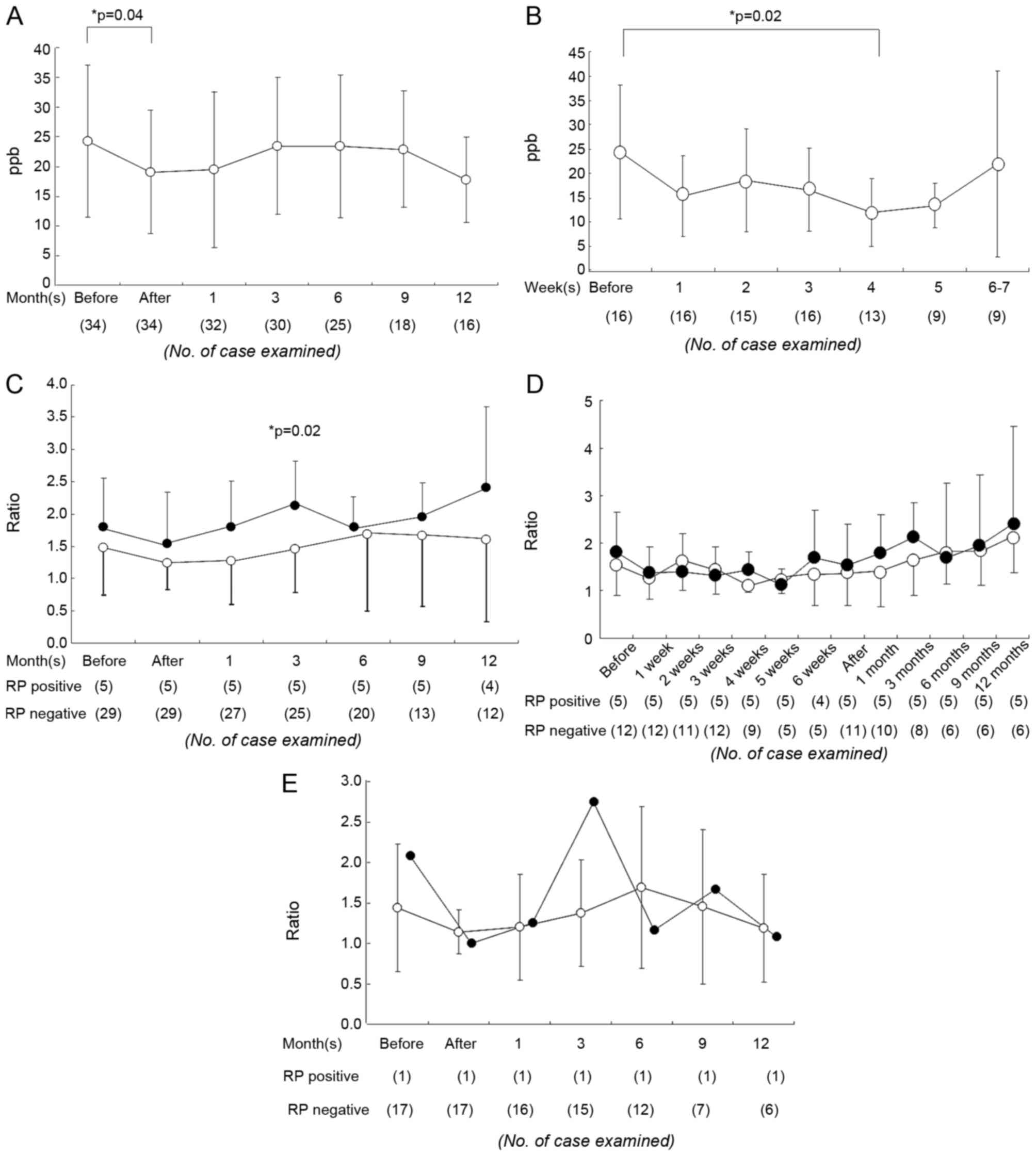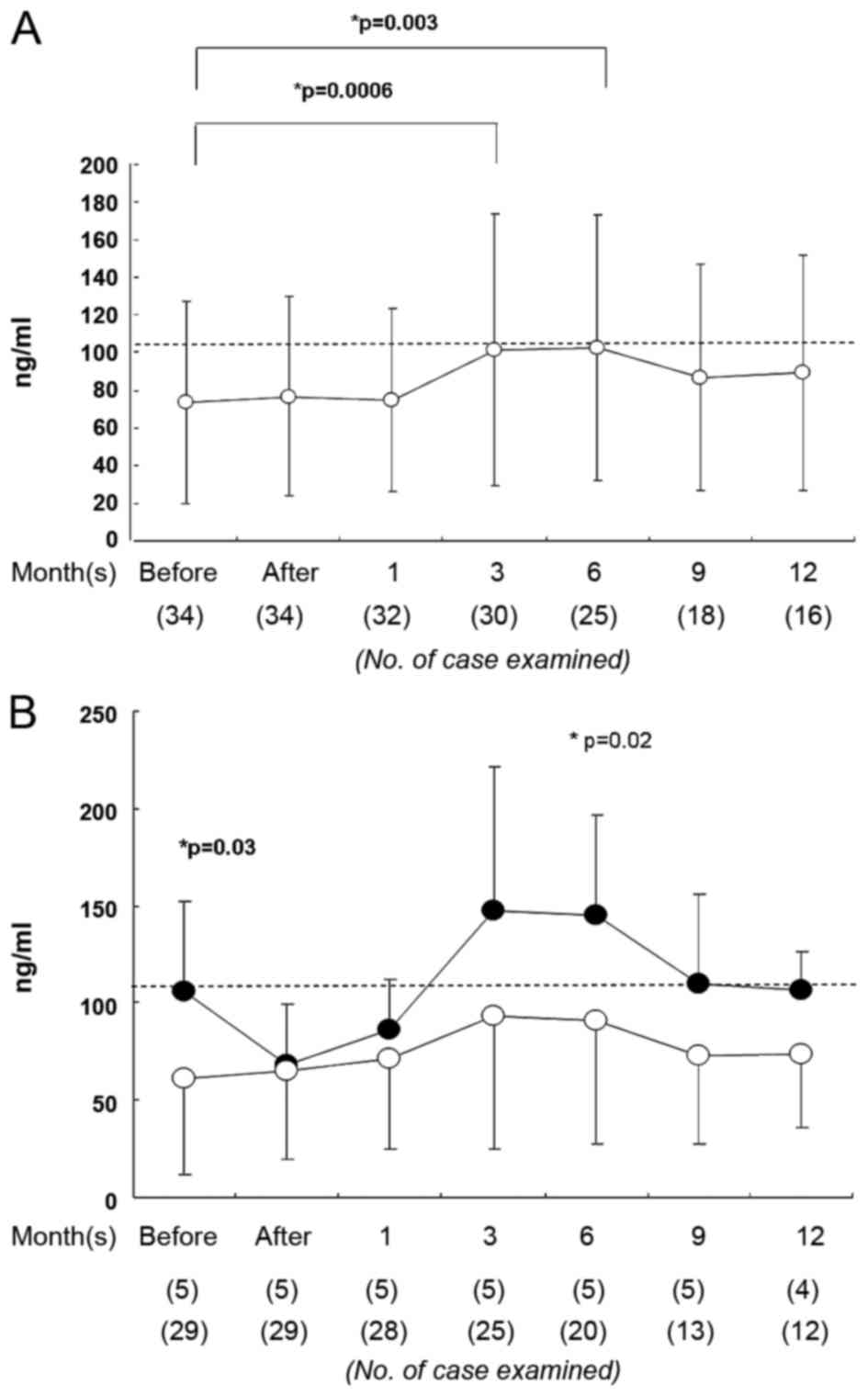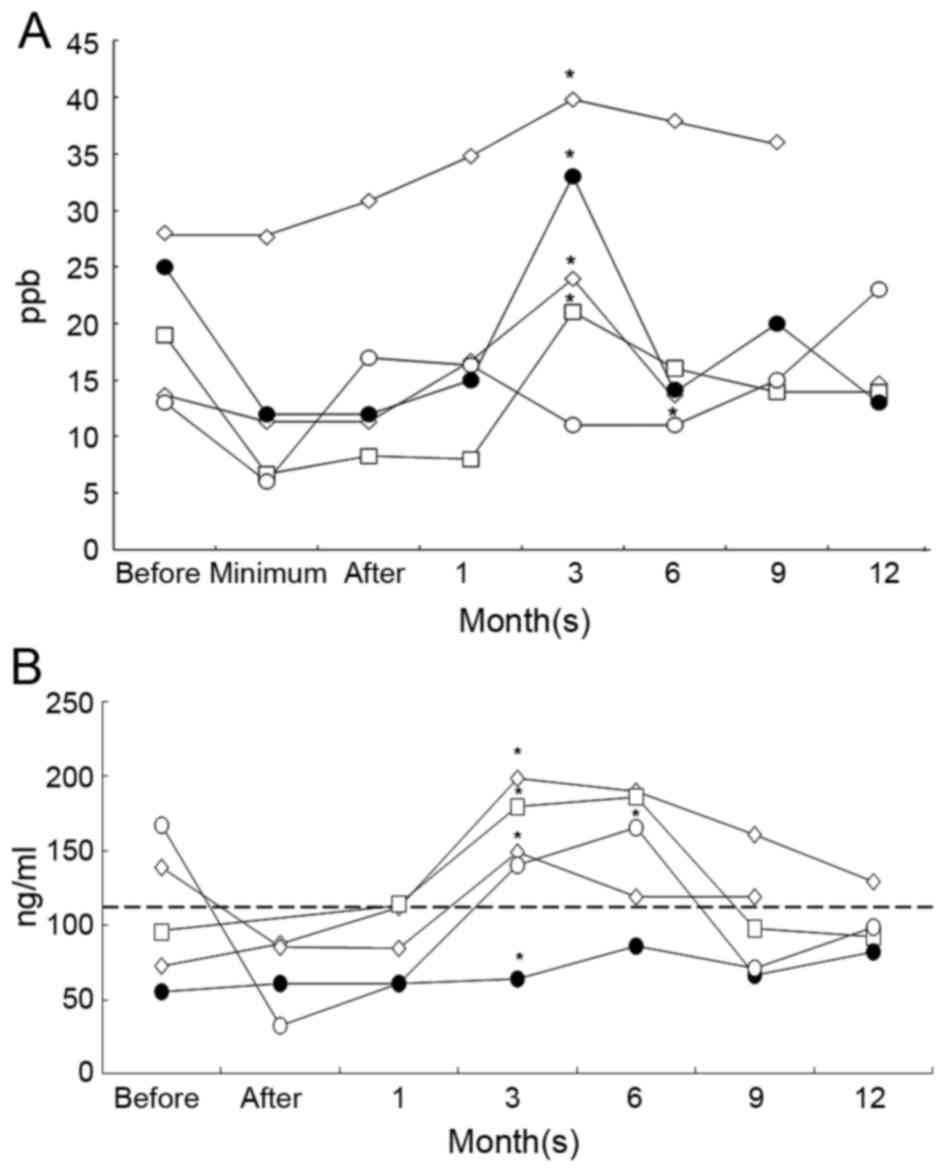|
1
|
Hart CM: Nitric oxide in adult lung
disease. Chest. 115:1407–1417. 1999. View Article : Google Scholar : PubMed/NCBI
|
|
2
|
Alving K, Weitzberg E and Lundberg JM:
Increased amount of nitric oxide in exhaled air of asthmatics. Eur
Respir J. 6:1368–1370. 1993.PubMed/NCBI
|
|
3
|
Dweik RA, Boggs PB, Erzurum SC, Irvin CG,
Leigh MW, Lundberg JO, Olin AC, Plummer AL and Taylor DR: American
Thoracic Society Committee on Interpretation of Exhaled Nitric
Oxide Levels (FENO) for Clinical Applications: An official ATS
clinical practice guideline: Interpretation of exhaled nitric oxide
levels (FENO) for clinical applications. Am J Respir Crit Care Med.
184:602–615. 2011. View Article : Google Scholar : PubMed/NCBI
|
|
4
|
Dummer JF, Epton MJ, Cowan JO, Cook JM,
Condliffe R, Landhuis CE, Smith AD and Taylor DR: Predicting
corticosteroid response in chronic obstructive pulmonary disease
using exhaled nitric oxide. Am J Respir Crit Care Med. 18:846–852.
2009. View Article : Google Scholar
|
|
5
|
Tiev KP, Hua-Huy T, Kettaneh A, Allanore
Y, Le-Dong NN, Duong-Quy S, Cabane J and Dinh-Xuan AT: Alveolar
concentration of nitric oxide predicts pulmonary function
deterioration in scleroderma. Thorax. 67:157–163. 2012. View Article : Google Scholar : PubMed/NCBI
|
|
6
|
Koizumi M, Yamazaki H, Toyokawa K,
Yoshioka Y, Suzuki G, Ito M, Shinkawa K, Nishino K, Watanabe Y,
Inoue T, et al: Influence of thoracic radiotherapy on exhaled
nitric oxide levels in patients with lung cancer. Jpn J Clin Oncol.
31:142–146. 2001. View Article : Google Scholar : PubMed/NCBI
|
|
7
|
Sasaki R, Soejima T, Matsumoto A, Maruta
T, Yamada K, Ota Y, Kawabe T, Nishimura H, Sakai E, Ejima Y and
Sugimura K: Clinical significance of serum pulmonary surfactant
proteins A and D for the early detection of RP. Int J Radiat Oncol
Biol Phys. 50:301–307. 2001. View Article : Google Scholar : PubMed/NCBI
|
|
8
|
Yamashita H, Kobayashi-Shibata S, Terahara
A, Okuma K, Haga A, Wakui R, Ohtomo K and Nakagawa K: Prescreening
based on the presence of CT-scan abnormalities and biomarkers (KL-6
and SP-D) may reduce severe radiation pneumonitis after
stereotactic radiotherapy. Radiat Oncol. 5:322010. View Article : Google Scholar : PubMed/NCBI
|
|
9
|
International Union Against Cancer: TNM
Classification of Malignant Tumours. Sobin LH, Gospodarowicz MK and
Wittekind CH: 7th. Wiley-Blackwell; Hoboken, NJ: 2009
|
|
10
|
Cancer Therapy Evaluation Program: Common
Toxicity Criteria. Version 2.0. http://ctep.cancer.gov/protocolDevelopment/electronic_applications/docs/ctcv20_4-30-992.pdfAccessed.
April 30–1999.
|
|
11
|
Oxford University Press, . Prescribing,
recording, and reporting photon-beam intensity-modulated radiation
therapy (IMRT). J ICRU. 10:Report 83. 2010.
|
|
12
|
Cancer Therapy Evaluation Program: Common
Terminology Criteria for Adverse Events. CTCAEv 4.0. https://ctep.cancer.gov/protocoldevelopment/electronic_applications/ctc.htmAccessed.
September 14–2016.
|
|
13
|
Guida G, Culla B, Scirelli T, Bellone G,
Sciascia S, Brussino L, Novero D, Palestro G, Heffler E, Gavarotti
P, et al: Exhaled nitric oxide and nitric oxide synthase expression
in Hodgkin's disease. Int J Immunopathol Pharmacol. 22:1027–1034.
2009. View Article : Google Scholar : PubMed/NCBI
|
|
14
|
Holmkvist T, Erlanson M, Meriläinen P and
Högman M: Exhaled nitric oxide is highly increased in a case of
Hodgkin's disease. Acta Oncol (Madr). 42:788–789. 2003. View Article : Google Scholar
|
|
15
|
Wewel AR, Crusius JA, Gatzemeier U,
Heckmayr M, Becher G, Magnussen H, Jörres RA and Holz O: Time
course of exhaled hydrogen peroxide and nitric oxide during
chemotherapy. Eur Respir J. 27:1033–1039. 2006.PubMed/NCBI
|
|
16
|
Liu CY, Wang CH, Chen TC, Lin HC, Yu CT
and Kuo HP: Increased level of exhaled nitric oxide and
up-regulation of inducible nitric oxide synthase in patients with
primary lung cancer. Br J Cancer. 78:534–541. 1998. View Article : Google Scholar : PubMed/NCBI
|
|
17
|
Enache I, Noel G, Jeung MY, Meyer N,
Oswald-Mammosser M, Urban-Kraemer E, Schumacher C, Geny B, Quoix E
and Charloux A: Can exhaled NO fraction predict
radiotherapy-induced lung toxicity in lung cancer patients? Radiat
Oncol. 7:1172012. View Article : Google Scholar : PubMed/NCBI
|
|
18
|
Toyokawa K, Yamazaki H, Koizuni M and
Inoue T and Inoue T: Assessment of exhaled NO concentration in
monitoring RP in patient who underwent thoracic radiotherapy for
lung cancer. Nihon Igaku Hoshasen Gakkai Zasshi. 61:347–349.
2001.(In Japanese). PubMed/NCBI
|
|
19
|
Koizumi M, Yamazaki H, Toyokawa K, Ozeki
S, Matsumura S and Inoue T and Inoue T: Influence of in vitro
radiation on changes in nitric oxide in rat macrophages and smooth
muscle cells. Anticancer Res. 23:331–334. 2003.PubMed/NCBI
|
|
20
|
McCurdy MR, Wazni MW, Martinez J, McAleer
MF and Guerrero T: Exhaled nitric oxide predicts RP in esophageal
and lung cancer patients receiving thoracic radiation. Radiother
Oncol. 101:443–448. 2011. View Article : Google Scholar : PubMed/NCBI
|
|
21
|
Guerrero T, Martinez J, McCurdy MR, Wolski
M and McAleer MF: Elevation in exhaled nitric oxide predicts for
radiation pneumonitis. Int J Radiat Oncol Biol Phys. 82:981–988.
2012. View Article : Google Scholar : PubMed/NCBI
|
|
22
|
Moré JM, Eclov NC, Chung MP, Wynne JF,
Shorter JH, Nelson DD Jr, Hanlon AL, Burmeister R, Banos P, Maxim
PG, et al: Feasibility and potential utility of multicomponent
exhaled breath analysis for predicting development of radiation
pneumonitis after stereotactic ablative radiotherapy. J Thorac
Oncol. 9:957–964. 2014. View Article : Google Scholar : PubMed/NCBI
|
|
23
|
Yamazaki H, Tang JT and Inoue T, Teshima
T, Ohtani M, Ikeda H, Itou M, Takeuchi E and Inoue T: Radiographic
changes following radiotherapy in the patients with lung cancer. Is
the irradiated area of the mediastinum in the simulation film a
significant factor? Strahlenther Onkol. 171:272–277.
1995.PubMed/NCBI
|
|
24
|
Yamashita H, Takahashi W, Haga A and
Nakagawa K: Radiation pneumonitis after stereotactic radiation
therapy for lung cancer. World J Radiol. 6:708–715. 2014.
View Article : Google Scholar : PubMed/NCBI
|
|
25
|
Matsuno Y, Satoh H, Ishikawa H, Kodama T,
Ohtsuka M and Sekizawa K: Simultaneous measurements of KL-6 and
SP-D in patients undergoing thoracic radiotherapy. Med Oncol.
23:75–82. 2006. View Article : Google Scholar : PubMed/NCBI
|
|
26
|
Takahashi H, Imai Y, Fujishima T,
Shiratori M, Murakami S, Chiba H, Kon H, Kuroki Y and Abe S:
Diagnostic significance of surfactant proteins A and D in sera from
patients with radiation pneumonitis. Eur Respir J. 17:481–487.
2001. View Article : Google Scholar : PubMed/NCBI
|
|
27
|
Zhang J, Li B, Ding X, Sun M, Li H, Yang
M, Zhou C, Yu H, Liu H and Yu G: Genetic variants in inducible
nitric oxide synthase gene are associated with the risk of
radiation-induced lung injury in lung cancer patients receiving
definitive thoracic radiation. Radiother Oncol. 111:194–198. 2014.
View Article : Google Scholar : PubMed/NCBI
|












